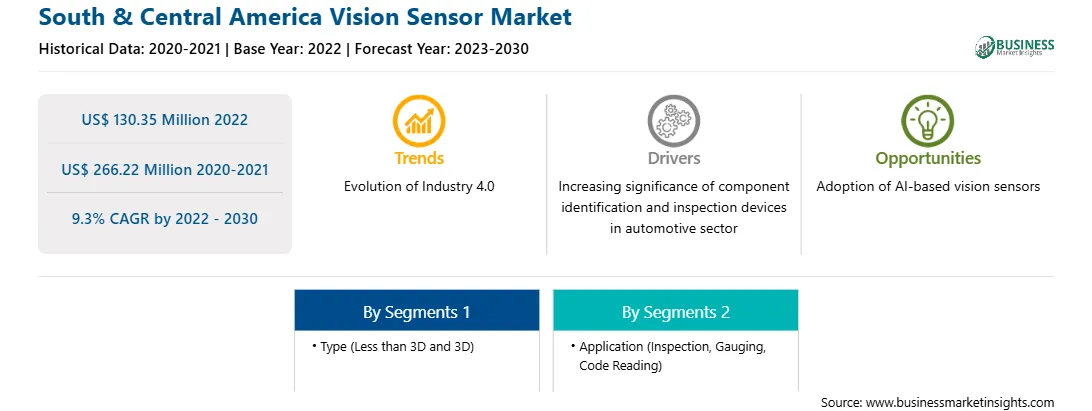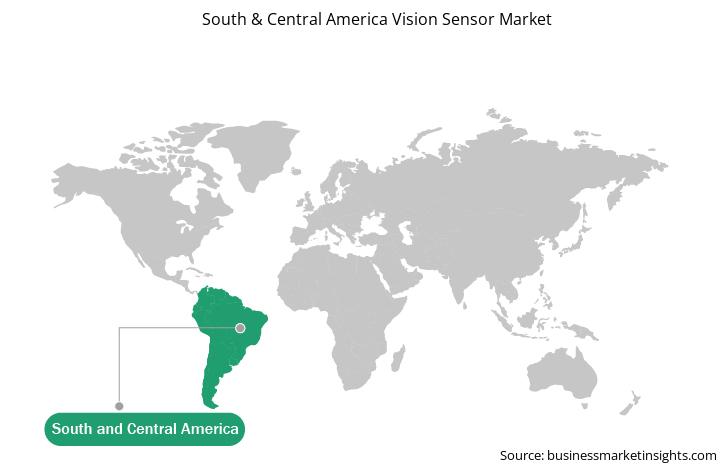The South & Central America vision sensor market was valued at US$ 130.35 million in 2022 and is expected to reach US$ 266.22 million by 2030; it is estimated to register a CAGR of 9.3% from 2022 to 2030.
Growing adoption associated with significant benefits offered by AI technology to the industries is creating opportunities in the vision sensor market growth. The demand for AI-based vision sensors has surged in recent years. AI-based vision sensors are revolutionizing different applications and industries. This encourages manufacturers to develop AI-based vision sensors that optimize quality control by identifying defects, improving production efficiency, and reducing waste, which is expected to create lucrative opportunities in the vision sensor market. For instance:
The growth of the South America vision sensor market is driven by increasing government initiatives and funding to encourage the adoption of sustainable solutions. In 2023, the Minister of Development, Industry, Commerce and Services (MDIC) of Brazil, Geraldo Alckmin, and the President of the National Bank for Economic and Social Development (BNDES) signed a Technical Cooperation Agreement (ACT) that included an investment of US$ 40 million for decarbonization of the automotive chain and promoting the adoption of electric vehicles (EVs) in the region. Vision sensors are highly used for inspecting the battery production process and quality control in the assembly of electric vehicles. Thus, the growing adoption of electric vehicles among consumers further propels the vision sensor market in South America.
Strategic insights for the South & Central America Vision Sensor provides data-driven analysis of the industry landscape, including current trends, key players, and regional nuances. These insights offer actionable recommendations, enabling readers to differentiate themselves from competitors by identifying untapped segments or developing unique value propositions. Leveraging data analytics, these insights help industry players anticipate the market shifts, whether investors, manufacturers, or other stakeholders. A future-oriented perspective is essential, helping stakeholders anticipate market shifts and position themselves for long-term success in this dynamic region. Ultimately, effective strategic insights empower readers to make informed decisions that drive profitability and achieve their business objectives within the market.

| Report Attribute | Details |
|---|---|
| Market size in 2022 | US$ 130.35 Million |
| Market Size by 2030 | US$ 266.22 Million |
| Global CAGR (2022 - 2030) | 9.3% |
| Historical Data | 2020-2021 |
| Forecast period | 2023-2030 |
| Segments Covered |
By Type
|
| Regions and Countries Covered | South and Central America
|
| Market leaders and key company profiles |
The geographic scope of the South & Central America Vision Sensor refers to the specific areas in which a business operates and competes. Understanding local distinctions, such as diverse consumer preferences (e.g., demand for specific plug types or battery backup durations), varying economic conditions, and regulatory environments, is crucial for tailoring strategies to specific markets. Businesses can expand their reach by identifying underserved areas or adapting their offerings to meet local demands. A clear market focus allows for more effective resource allocation, targeted marketing campaigns, and better positioning against local competitors, ultimately driving growth in those targeted areas.

The South & Central America vision sensor market is categorized into type, application, industry vertical, and country.
Based on type, the South & Central America vision sensor market is bifurcated into less than 3D and 3D. The less than 3D segment held a larger market share in 2022.
In terms of application, the South & Central America vision sensor market is categorized into inspection, gauging, code reading, and others. The code reading segment held the largest market share in 2022.
By industry vertical, the South & Central America vision sensor market is segmented into automotive, electronics, industrial manufacturing, food & beverages, and others. The automotive segment held the largest market share in 2022.
Based on country, the South & Central America vision sensor market is segmented into Brazil, Argentina, and the Rest of South & Central America. Brazil dominated the South & Central America vision sensor market share in 2022.
Cognex Corp, Teledyne Technologies Inc, Keyence Corp, Sick AG, Balluff GmbH, Baumer Holding AG, Pepperl+Fuchs SE, Ifm Electronic GmbH, Hans Turck GmbH & Co.KG, and Leuze Electronic GmbH & Co KG are some of the leading companies operating in the South & Central America vision sensor market.
The South & Central America Vision Sensor Market is valued at US$ 130.35 Million in 2022, it is projected to reach US$ 266.22 Million by 2030.
As per our report South & Central America Vision Sensor Market, the market size is valued at US$ 130.35 Million in 2022, projecting it to reach US$ 266.22 Million by 2030. This translates to a CAGR of approximately 9.3% during the forecast period.
The South & Central America Vision Sensor Market report typically cover these key segments-
The historic period, base year, and forecast period can vary slightly depending on the specific market research report. However, for the South & Central America Vision Sensor Market report:
The South & Central America Vision Sensor Market is populated by several key players, each contributing to its growth and innovation. Some of the major players include:
The South & Central America Vision Sensor Market report is valuable for diverse stakeholders, including:
Essentially, anyone involved in or considering involvement in the South & Central America Vision Sensor Market value chain can benefit from the information contained in a comprehensive market report.